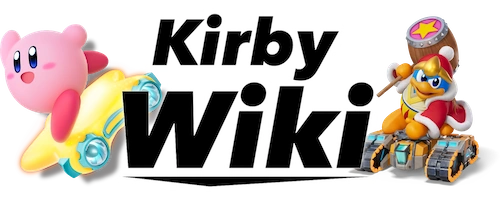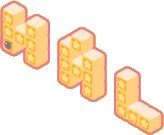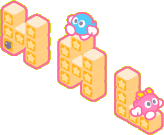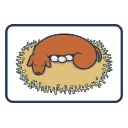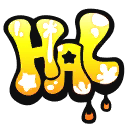(→Trivia) Tag: Visual edit |
(It's both.) |
||
| (One intermediate revision by one other user not shown) | |||
| Line 4: | Line 4: | ||
==History== |
==History== |
||
[[File:HAL_Logo_1980-88.png|thumb|The HAL Logo from 1980 to 1988]] |
[[File:HAL_Logo_1980-88.png|thumb|The HAL Logo from 1980 to 1988]] |
||
| − | HAL Laboratory's first games were made in the early 1980s for home computers like the MSX, Apple II, VIC-20, and Commodore 64. |
+ | HAL Laboratory's first games were made in the early 1980s for home computers like the MSX, Apple II, VIC-20, and Commodore 64. |
Prior to the creation of Kirby, HAL Laboratory was most well known for the ''[https://en.wikipedia.org/wiki/Eggerland Eggerland] ''puzzle-action game series, which made its debut with ''Eggerland Mystery'' on MSX in 1985, and for the ''Hole in One ''golf simulation series. Their first title created for a Nintendo platform was ''F1 Race'', a 1984 racing game for the Famicom that was published by Nintendo exclusively in Japan. In 1985, ''F1 Race'' was reworked into ''Mach Rider'', which was made for both the NES and the Famicom. It replaced the race car with a futuristic motorcycle, and added new gameplay elements. HAL's work on both games went officially uncredited by Nintendo, though the developers were able to hide their names in a high score listing, along with a reference to ''Eggerland''. <ref>[https://www.mobygames.com/game/nes/mach-rider/credits Moby Games]</ref> |
Prior to the creation of Kirby, HAL Laboratory was most well known for the ''[https://en.wikipedia.org/wiki/Eggerland Eggerland] ''puzzle-action game series, which made its debut with ''Eggerland Mystery'' on MSX in 1985, and for the ''Hole in One ''golf simulation series. Their first title created for a Nintendo platform was ''F1 Race'', a 1984 racing game for the Famicom that was published by Nintendo exclusively in Japan. In 1985, ''F1 Race'' was reworked into ''Mach Rider'', which was made for both the NES and the Famicom. It replaced the race car with a futuristic motorcycle, and added new gameplay elements. HAL's work on both games went officially uncredited by Nintendo, though the developers were able to hide their names in a high score listing, along with a reference to ''Eggerland''. <ref>[https://www.mobygames.com/game/nes/mach-rider/credits Moby Games]</ref> |
||
| Line 52: | Line 52: | ||
[[File:Jambandra HAL.jpg|thumb]] |
[[File:Jambandra HAL.jpg|thumb]] |
||
*In ''[[Kirby Star Allies]]'', the word "HAL" can be found on [[Jambandra Base]] in [[Far-Flung - Starlight Heroes]]'s overworld map. However, it is very hard to see. |
*In ''[[Kirby Star Allies]]'', the word "HAL" can be found on [[Jambandra Base]] in [[Far-Flung - Starlight Heroes]]'s overworld map. However, it is very hard to see. |
||
| + | *In ''[[Super Kirby Clash]]'', the word "HAL" rarely appears written in clouds in the sky of both [[Village|villages]], slowly drifting from left to right. |
||
==Trivia== |
==Trivia== |
||
Revision as of 21:47, 23 July 2020

The current logo.
HAL Laboratory, Inc. (株式会社ハル研究所, Kabushikigaisha Haru Kenkyūjo) is a Japanese video game company that was founded on February 21, 1980. The company is most famous for its character Kirby, the protagonist of the eponymous video game series, as well as the Super Smash Bros. series. It is a second-party development studio of Nintendo.
History

The HAL Logo from 1980 to 1988
HAL Laboratory's first games were made in the early 1980s for home computers like the MSX, Apple II, VIC-20, and Commodore 64.
Prior to the creation of Kirby, HAL Laboratory was most well known for the Eggerland puzzle-action game series, which made its debut with Eggerland Mystery on MSX in 1985, and for the Hole in One golf simulation series. Their first title created for a Nintendo platform was F1 Race, a 1984 racing game for the Famicom that was published by Nintendo exclusively in Japan. In 1985, F1 Race was reworked into Mach Rider, which was made for both the NES and the Famicom. It replaced the race car with a futuristic motorcycle, and added new gameplay elements. HAL's work on both games went officially uncredited by Nintendo, though the developers were able to hide their names in a high score listing, along with a reference to Eggerland. [1]
The Eggerland series would eventually move onto the Famicom Disk System and then the Famicom, before it was brought to the NES for Western territories and renamed Adventures of Lolo. HAL later abandoned the Eggerland series in favor of Kirby, but it received two final entries on Game Boy and Windows PC that postdated the release of Kirby's Dream Land. Despite being a defunct game series, HAL Laboratory continues to pay homage to it within the Kirby game series through the characters Lololo and Lalala.
Before HAL Laboratory was bought by Nintendo, a game titled Metal Slader Glory was released for the Famicom in 1991. Despite having a development of more than 4 years, having a 8 megabit cartridge (the largest at the time), and having advanced graphics, the game sold poorly, which led HAL Laboratory to bankruptcy. Nintendo then bought the company, ending HAL Laboratory's life as an independent publisher. Nevertheless, HAL maintained enough autonomy through the 1990s that they continued to self-publish some of their own games, and would still occasionally cooperate with other publishers and licensors, even releasing two more games on non-Nintendo platforms (Revival! Eggerland for Windows PCs, and Mingle Magnet for WonderSwan). Since the year 2001, HAL has become more closely tied to Nintendo, and their sysdolphin game development software suite was provided by Nintendo to third-party GameCube developers.

Spring Logo
In many of its games during the early to mid-1990s it used the name HALKEN (derived from their literal Japanese name "HAL KENkyūjo") as well as HAL Laboratory. Some of its early titles were also released as HAL America, a North American subsidiary of the company. At the time, HALKEN has two variations of its logo: one of them was the Spring mark. In Japanese pronunciation, "HAL" is "はる (haru)," and "春 (Spring)" is also pronounced "はる." "Spring" can also mean a physical tool, "バネ," so this logo was modeled on the physical tool, "Spring."

The HAL Corporation logo as seen in Blade (GBC)
Beginning in the 1990s, HAL Laboratory also used the name "HAL Corporation" for a handful of games that were either made for non-Nintendo platforms, or published by companies other than Nintendo. This name may have been used as a loophole to work around the terms of an exclusivity agreement with Nintendo. The last game to use the HAL Corporation name was Blade on Game Boy Color, a movie tie-in published by Activision in 2000. Perhaps to maintain good relations with Nintendo, HAL Laboratory has never acknowledged any HAL Corporation games as being part of their portfolio, and they are not listed on the company's official release timeline. [2]
An important figure of HAL Laboratory is Masahiro Sakurai, who created the Kirby character and the Super Smash Bros. franchise, and now leads his own company, Sora Ltd. Sakurai resigned from HAL Laboratory in 2003 after criticizing Nintendo's handling of Kirby Air Ride's development, but continues to be involved with Nintendo through Sora Ltd.
HAL Egg
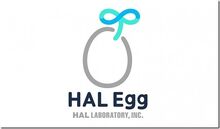
The HAL Egg logo
In 2017, HAL Laboratory made a return as an independent publisher with its new company brand HAL Egg. The brand was established to focus on new ideas and gameplay concepts outside of the Kirby series. To date, one game has been released under the HAL Egg name: Part Time UFO, a physics-based puzzle/action game for iOS and Android devices. [3] Initially released in Japan in November 2017, it received a localized English version in February 2018.
Influences on the Kirby series
HAL Rooms
| Main article: HAL Room |
A recurring Easter egg in many Kirby games is a hidden area containing Star Blocks arranged to spell out "HAL." Not all HAL Rooms are hidden in obscure locations, nor do all make use of Star Blocks to spell out the company's name.
Game Cameos
| Main article: Cameos |
Many of HAL Laboratory's other properties reference the Kirby series or are referenced in Kirby games. These include the following:
- Eggerland series (1985-2001)
- Revenge of the 'Gator (1989)
- Uchuu Keibitai SDF (1990)
- HyperZone (1991)
- Trax (1991)
- Arcana (1992)
- EarthBound (1994)
- Super Smash Bros. series (1998-)
- BOXBOY! series (2015-)
- Picross 3D: Round 2 (2016)
Other influences and references
- The current logo appears in the Paint Panic sub-game in Kirby: Canvas Curse. In Kirby Super Star Ultra and onward, it also makes a cameo appearance as a possible Stone transformation. It appears as a balloon sculpture Circus Kirby can attack with and as a camouflage Archer Kirby can hide behind.
- The level names of the levels in the Challenge Mode of Kirby's Dream Collection Special Edition (Happiness Hall, Apricot Atrium, and Last Land) spell out the abbreviation "HAL." This is one of the many level acronyms used throughout the series.
- The company's name may have had an influence on the names of several important elements in the series: Battleship Halberd in Kirby Super Star (and its remake), Halcandra in Kirby's Return to Dream Land, Haldera Volcano in Kirby Fighters Deluxe, and the Haltmann Works Company in Kirby: Planet Robobot.
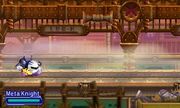
- The platform number at the train station in Stage 3 of Patched Plains is L∀∀-H. When flipped upside-down, the number becomes H-AA˥, a possible reference to HAL Laboratory.
- Star Dream and Star Dream Soul OS use the letters H, A, and L to attack Kirby (though Star Dream releases them in reverse order).
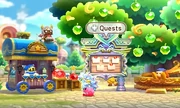
- In Team Kirby Clash Deluxe, if Kirby purchases all weapons and armor, the Shoppe changes appearance. The crates beside the cart have the letters H, A, and L engraved on their sides.
- In Kirby's Blowout Blast, Score Coins appear when Kirby defeats each boss in the Secret Path. The coins that appear after defeating Masher, Kracko's Revenge, and Mega Masher form the letters H, A, and L, respectively.

- In Kirby Star Allies, the word "HAL" can be found on Jambandra Base in Far-Flung - Starlight Heroes's overworld map. However, it is very hard to see.
- In Super Kirby Clash, the word "HAL" rarely appears written in clouds in the sky of both villages, slowly drifting from left to right.
Trivia
- The president of Nintendo from 2002-2015, Satoru Iwata, was formerly president of HAL from 1993-2000, having first joined the company in 1983.
- The "HAL" in the company's name was chosen because, alphabetically, each letter was one space ahead of IBM, suggesting superiority over the technology corporation.[4]
- As HAL sounds like the Japanese pronunciation of 8 and 6, the number 86 is featured on various occasions as a reference to HAL.
- In Stage 5 of Royal Road, Stage 4 of Access Ark, and Heavenly Hall, if the player waits for 86 seconds in certain rooms, a HAL Room can be discovered.
- In Dedede's Drum Dash Deluxe, the maximum score in C-R-O-W-N-E-D (Reprise) is 86555, which becomes "HAL GO GO GO" when the numbers are pronounced in Japanese. This number is also the score reward for defeating Void in Kirby Star Allies.
- In Team Kirby Clash, the maximum EXP is 39860, which becomes "Thank You HAL" when the numbers are pronounced in Japanese.
- Several Heroic Missions in Team Kirby Clash Deluxe have 86 Gem Apples as the reward.

HAL Laboratory's 40th anniversary
- For their 40th anniversary, the employees of HAL Laboratory drew a plethora of characters from media they've created, which included Kirby series characters.
- A contemporary developer group known as "H. A. L. Labs", founded by Greg Autry, published an unlicensed clone of Namco's PAC-MAN known as "Taxman" on the Apple II platform in 1982. The company is not related to HAL Laboratory other than the similar name.
